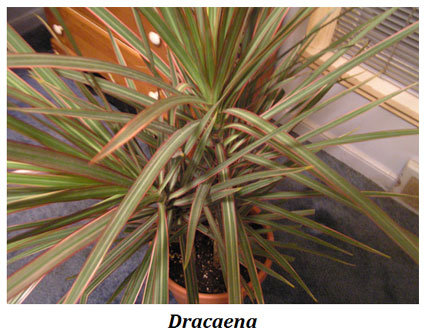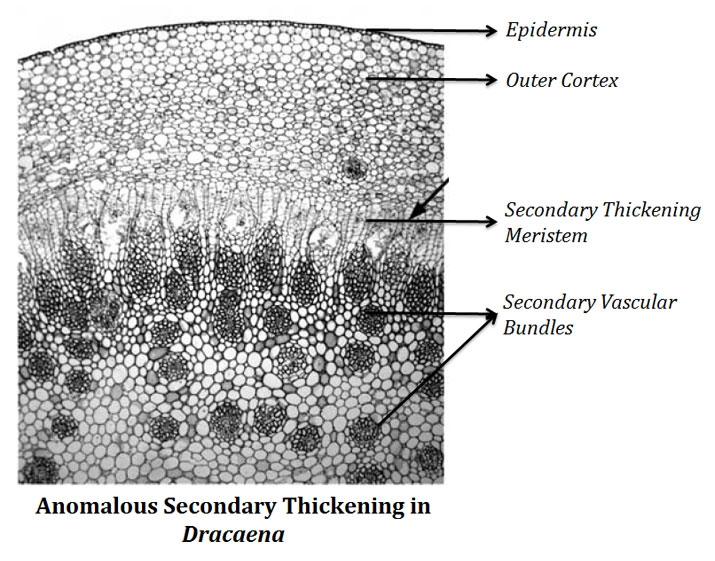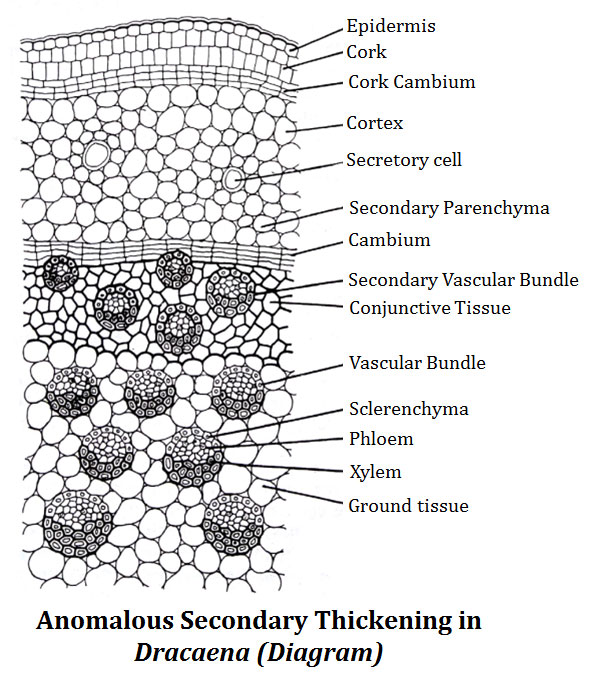Secondary thickening in monocot plants is a rare phenomenon that occurs in only a few species, such as Dracaena, Yucca, and Agave. Unlike most monocots, which exhibit limited or no secondary growth, these plants have the ability to produce new vascular tissues and increase their stem girth over time. Interestingly, secondary thickening in monocots is quiet different from that in dicots. The present post discusses the anomalous secondary growth in Dracaena with diagram.
Before going to the secondary thickening in Dracaena, first see what anomalous secondary thickening is and how the process of anomalous secondary thickening happens in plants.
What is Anomalous Secondary Thickening?
Ø In many plants, the pattern of the secondary thickening shows deviation from the normal type.
Ø The term “Anomalous Secondary Growth” is given for this deviation or variation.
Ø The anomalous secondary growth is more common in tropical plants.
Ø Anomalous secondary thickening is NOT an anomaly or disease in plants; rather it is an adaptation to suit the habit and habitat of the plant.
Reason for Anomalous Secondary Growth in Plants
$. The normal cambium behaves peculiarly or irregularly, resulting in the abnormal arrangement of the vascular tissue.
$. The normal cambium is situated in an abnormal position hence the tissue cut is placed abnormally.
$. The normal cambium does NOT develop or if present, it is replaced by additional or accessory cambial rings.
Anomalous Secondary Thickening in Monocots
Ø The secondary thickening is usually absent in monocot plants since the vascular bundles in monocots are closed type (no cambium).
Ø However, a very few plants in monocots shows anomalous secondary growth such as Dracaena, Yucca, Aloe, Sansevieria and Agave
Ø Such an anomalous secondary thickening in monocots is due to the activity of specialized primary thickening meristem
Ø The secondary thickening in Dracaena is the classical example for the anomalous secondary thickening in monocot plants.
Anomalous Secondary Thickening in Dracaena

Primary Structure
Ø The young stem of Dracaena is typical monocot stem and has the following parts.
Ø Epidermis – the outer most consists of single layer of parenchymatous cells.
Ø Hypodermis – situated just below the epidermis, composed of sclerenchymatous cells.
Ø Ground is tissue is undifferentiated- parenchymatous
Ø Vascular bundles – closed type, scatteredly arranged in the ground tissue.
Secondary Growth
Ø The secondary thickening is initiated by the formation of a special meristematic zone in the inner cortical region of the stem.
Ø A multilayered cambial ring is differentiated from the inner cortical cells lying outside the vascular bundles.
Ø This cambium is formed in the region of the stem which ceased its elongation.
Ø The shape of these cambial cells varies.
Ø The activity of this cambium is abnormal.
Ø It cut a large number of cells to the inner side and few amounts of cells to the outer side.
Ø The cells produced external to the cambium are parenchymatous.
Ø The cells produced inner to the cambium are partially parenchymatous and partially vascular in nature.

Ø The parenchymatous cells produced internally to the cambium develop into lignified conjunctive tissue.
Ø The vascular tissue produced internally to the cambium differentiated secondary vascular bundles
Ø The secondary vascular bundles are concentric- amphivassal type.
Ø The cells of the inner cambial ring participate in the formation of secondary vascular bundles.
Ø Usually, the secondary vascular bundles arise from a single initial cell called vascular bundle-initial.
Ø The vascular bundle-initial cell divide by two anticlinal division to form a raw of two or three cells.
Ø All these cells then undergo a periclinal division to form peripheral cells.
Ø Later divisions are irregular and to form a mass of cells.
Ø In this mass of cells, the centrally placed cell metamorphoses into phloem cells.
Ø The peripheral cells differentiated into xylem elements.
Ø Thus, the newly formed secondary vascular bundles consist of a centrally placed phloem which is surrounded by the xylem (concentric vascular bundle – amphivassal type)
Ø The cambium then cut parenchyma cells internally.
Ø The newly formed parenchyma cells push the vascular bundles towards the central region.
Ø After some time the cambium again behave abnormally to produce another ring of vascular bundles
Ø This process continues and many rings of concentrically arranged vascular bundles are formed.
Ø The last ring of vascular bundles is embedded in a mass of lignified conjunctive tissue.
Ø A cork cambium may also develop and this cork cambium can produce the bark.

<<< Back to PLANT ANATOMY Notes
| You may also like... | ||
|---|---|---|
| NOTES | QUESTION BANK | COMPETITIVE EXAMS. |
| PPTs | UNIVERSITY EXAMS | DIFFERENCE BETWEEN.. |
| MCQs | PLUS ONE BIOLOGY | NEWS & JOBS |
| MOCK TESTS | PLUS TWO BIOLOGY | PRACTICAL |
You might also like…
@. Boerhavia Anomalous Secondary Thickening
@. Vascular Bundles – Structure and Classification
